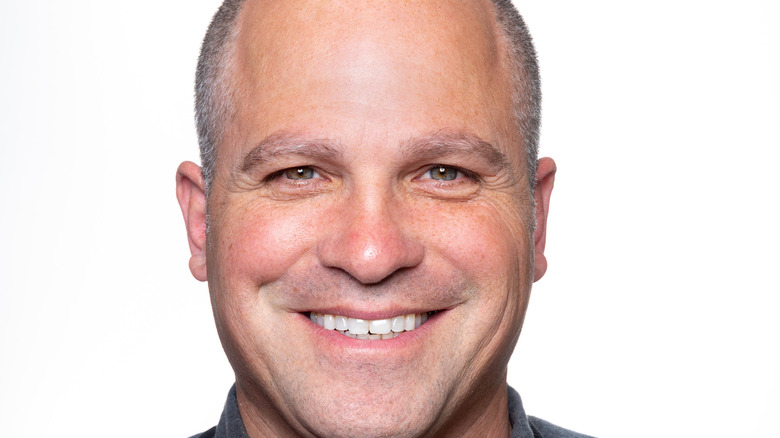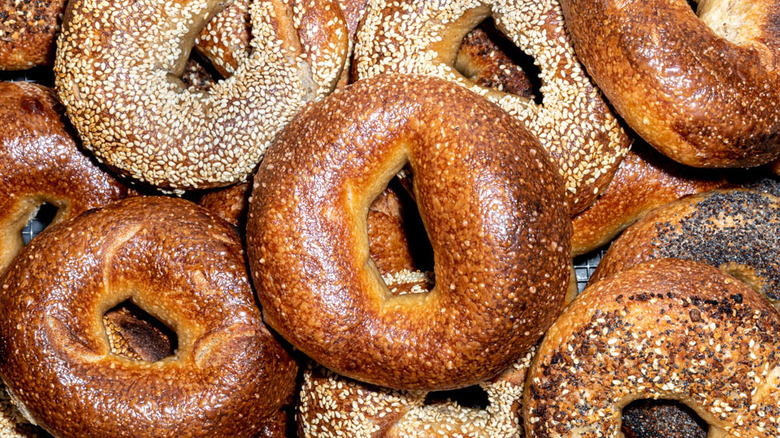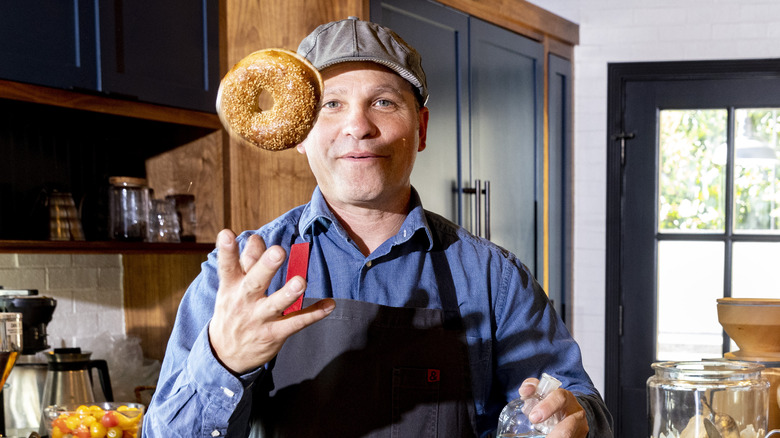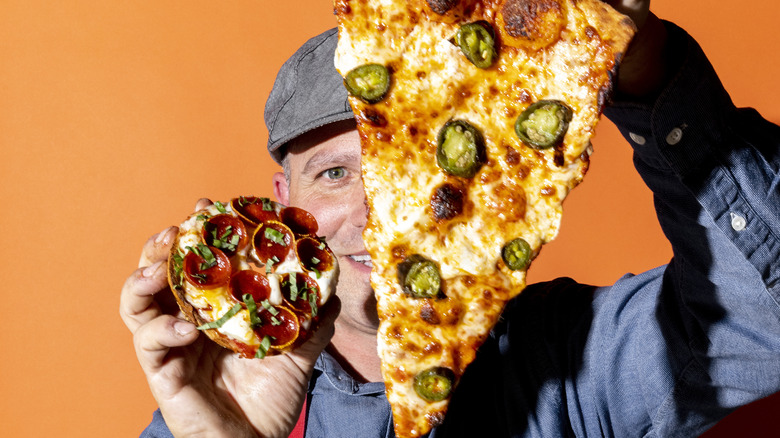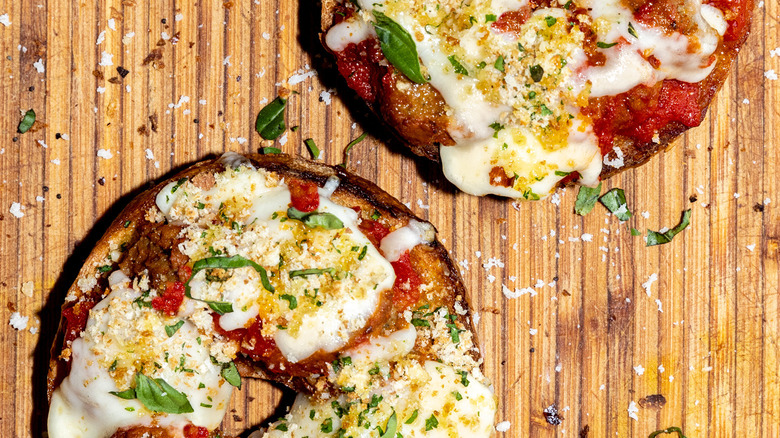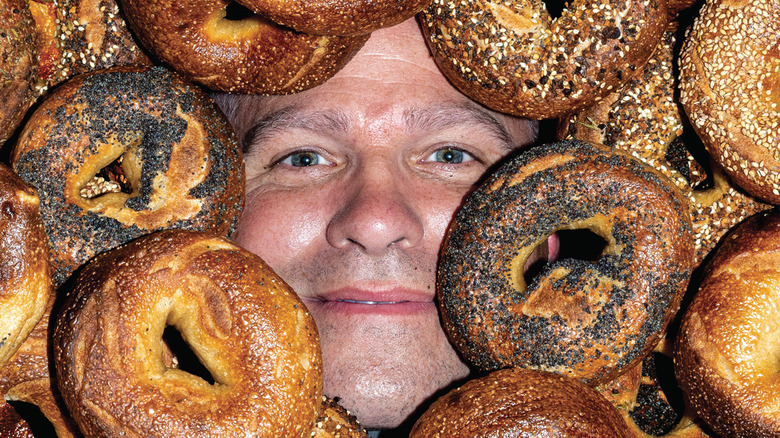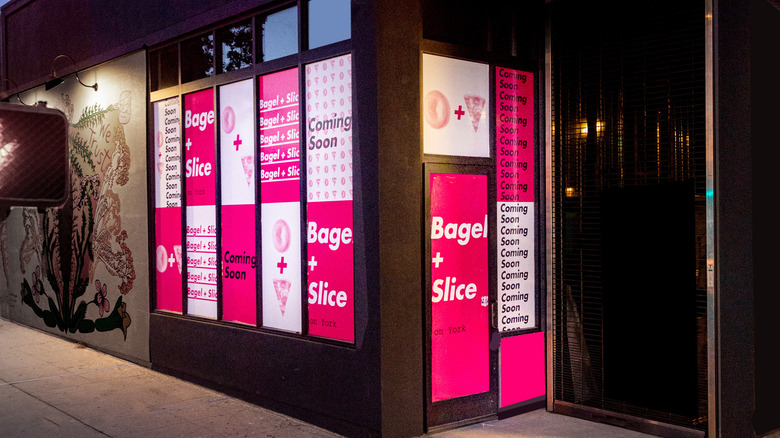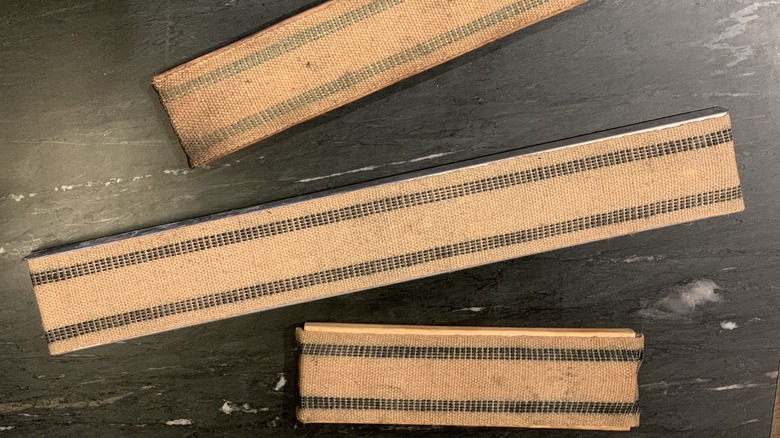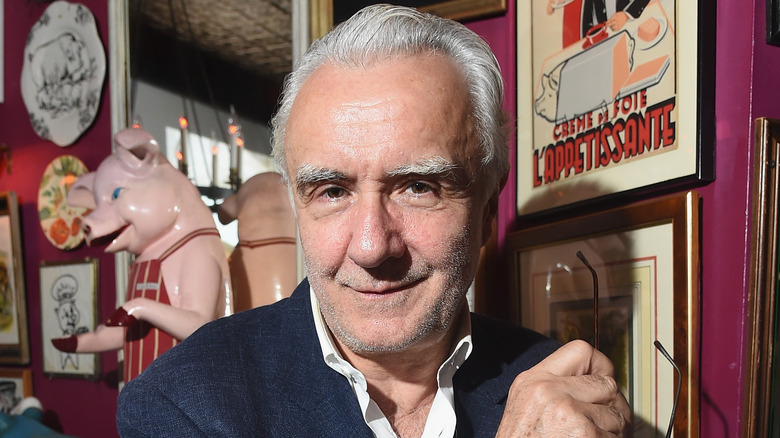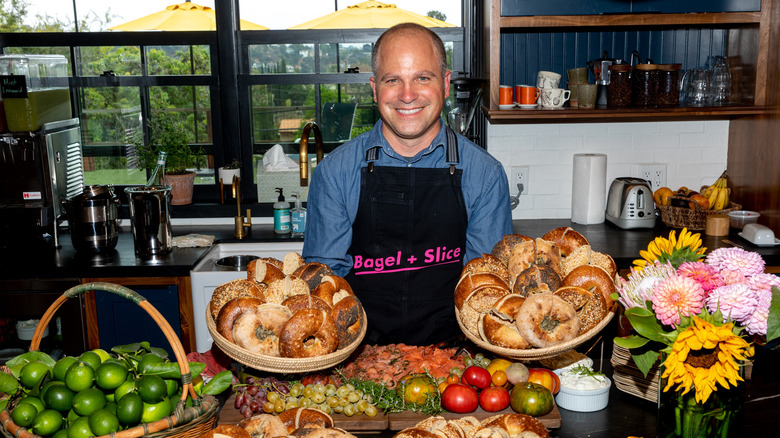Blaze Pizza Founder Brad Kent On Why He's Pivoting From Pizza To Bagels - Exclusive Interview
Brad Kent is a mad genius. He's co-founder of Blaze Pizza, the fast casual chain with over 240 locations nationally. Blaze is known for its delicious pizzas and the company's eco-friendly stance. Kent is a self-admitted food scientist, and in an exclusive interview with Mashed, he filled us in on his latest endeavor, Bagel + Slice, located in northeastern Los Angeles. Kent has been working for years on developing the perfect bagel; in his mind, the New York City-style bagel that your grandparents loved and remember fondly. Bagel baking has mostly become mechanized, and Kent is determined to show Los Angeles — and probably the rest of the world — what they've been missing.
Kent continues with Blaze's ecological mission, but he bumps it up a couple of notches. A true bagel starts with the wheat, and Kent sources his wheat from organic farmers, most of whom are local. But it's not just any wheat; it's hearty, flavorful, and aromatic. Kent needs to order 2,000 pounds at a time because it's the same wheat he uses for his pizza crust. Bagel + Slice (opening in December 2021) also changed Kent's outlook on life. Not only is he an eco-warrior, he's also a social activist and now works to restore his neighborhood and assist people displaced by the Covid-19 pandemic. Kent is funny and personable, and his breadth of knowledge is impressive. Read our full interview with him, and trust us, you'll never eat a packaged, frozen bagel again.
This is how you bake a better bagel, according to Brad Kent
In your opinion, what makes the perfect bagel?
Well, because I've been playing with bagels longer than pizza, I've been doing it since the early 2000s, and it's so many steps, and it's really about the end product and the steps that lead to that end product. Which means extremely high-quality flour that has a really good flavor. Because, unlike pizza, which is a higher amount of water-to-flour ratio, bagels have a higher flour-to-water ratio than a lot of bread. So the flour has to taste really good. So that's important. You've got to use some of the classic ingredients that are in a bagel to make it taste like a bagel. It should be a slightly sweet bread, typically sweetened with malt syrup. So you add malted barley or malted wheat to give it that flavor, which is the same flavor you get in really good beer, you would also get in really good bread, and bagels seem to be a little bit on the higher side of malt. So it's a malty bread product.
It should have the right chew in the crumb where then it has a give. And if you have dentures, I'm hoping that it wouldn't pull them out, but that it would give them a little bit of a fight ... It should have a natural crunch that shouldn't need to be enhanced by being toasted. However, as much as like in the Neapolitan Pizza world, you'd say "I would never add oil to my dough." Or, "I would never add salt to my dough." There's these rules that are hard and fast. Like in the bagel world, you would never toast the bagel. A really good bagel that's toasted, I think it's even better.
So I think it's something that should also toast well. And this one's going to be one of those things, people are going to go, "Wait a minute. This is not a bagel guy, this is like a pizza guy saying that it's okay to put pineapple up on a pizza." No. I think it's okay to toast a bagel. And I think that it should be hand-shaped. I think looking at a bagel, part of that experience of bagel eating and bagel enjoyment, is appreciating how unique each bagel is. In the fine-dining world, you try to have uniformity by having this incredible skill as a chef.
And there's been a movement lately to make things perfectly imperfect ... which is this dichotomy now of beliefs. Bagel I think, is this perfectly imperfect thing. So it might be, that's why it's this perfect food for today because you have to have that skill set of a very good chef and a very good bread maker. But you have to have something that a really good bread maker...doesn't always have, and that's this culinary grit where you wing it. You adjust things as the day sees fit in a culinary way versus in a scientific baker's way. I think that pizza dough, I think a high-quality pizza dough is more bread baker science, and I think that a good bagel is more chef science. So there's a slight difference between the two. So that's why it's hard to do both. And I think that bagels are a much harder thing to figure out than a pizza.
Do you think there's any truth that New York City water affects taste and texture?
Yes. And I didn't used to believe this until I started Blaze Pizza, and we opened restaurants around the countr,y and I realized that water is not just two Hs and an O. It's also a series of minerals, and also it has a pH. PH and minerality of water plays a critical role in gluten formation and in flavor. So yes, the water impacts taste because it's an ingredient in the dough. It impacts the flavor. Absolutely the flavor of anything that it's in. In soup, and in breads and bagels and pizzas, water definitely has a taste. But that doesn't mean you can't make great bagels with water from California, if you have the right level of water filtration in place to make your water taste good. So now you've addressed the flavor, but you didn't address the minerals or the pH. Minerals and pH of water impact gluten formation, which impact the chewiness and texture of your finished product.
The protein quality and the protein content of flour impacts the texture of your finished product. So when you mix water with flour, you develop gluten, when you mix those in a certain way, and you ferment a certain way and bake a certain way and boil a certain way, you get a texture. So if you make adjustments to your formulation, your process, your types of flour, the protein quality and the protein content of your flour, you can get a bagel that matches the quality and texture of a New York bagel without using New York water.
It took Brad Kent years to create his bagel recipe
What inspired you to pivot towards bagels?
Well, I actually pivoted to pizza because I couldn't figure out bagels years ago. So it's a pivot that's just taken this long to figure out, but I'm slow in everything that I do. Maybe I'm just not that bright or maybe I just like to really understand things deeply. And then I'm able to make tweaks and adjustments to things once I really deeply understand something, knowing that each tweak I make is going to give a desired outcome. Bagels are really complicated because there's so many steps involved in making a bagel. First, you have to choose the right ingredients, the right type of flour, the right hydration level of flour and water. You've got to mix it the right amount of time to develop the right amount of gluten, and then you've got to ferment it for a certain period of time.
And how long do you go with that? Is it a day, is it three? Is it a day before you shape them and then a day after that, before you boil them? Is it vice versa? Do you boil them cold, do you boil them at room temperature? All of these little details influence the end result. And so first the thing you've got to do is understand the bagel. And a bagel is simply just flour, water, yeast, fermentation, boil, bake, that kind of thing. But I wanted to get all that right first, before I started making changes. and I made a lot of tweaks from a traditional bagel to get to where it is. But the end result is something that when you eat it, if you grew up in the 1980s or before, when a bagel was truly a bagel, that you recognize it as that.
But if you are living today and you're born in the '90s and you never had one of these older bagels that was made by a bagel maker of the past, you'd think it's delicious because you understand what delicious food tastes like. When I eat bagels today that come from mixes or are shaped in a bagel-making machine, the texture is different, the flavor is different, the fermentation, the quality of the flour, the depth of flavor from fermentation and even just the mixing style influences the flavor and the color of the crumb. I'm a food scientist, so I apologize if I get a little deep.
And where I landed is with a formulation that's pretty complicated. There's a number of steps to making the bagel the way that I think is ideal in my world. Because there's some bagels out there that are amazing, some new style of bagels, but they're not traditional, and that's good. They're good on their own, but they're not going to make an old Jewish guy from Manhattan or East Coast who was born in the '40s, eat it and go like, "That reminds me of my youth." That's what I want to bring back. I'm trying to keep tradition alive in people's taste memory. And I want my children to grow up with that taste memory that I had of what a true bagel should taste like.
Brad Kent wants to change the bagel business in LA
Why are you still doing pizza if your focus is on bagels?
Well, I love pizza, and I think I'm good at it. And it started out... It was a big business decision to do bagels and pizzas at the same place because the bagel business is a really hard business to succeed in financially because you're closed more than half the day. And your rent is for the entire day. And in Los Angeles where rents are so high, workers' compensation is so high. And all these insurances are so high. The cost of doing business is insane. You've got to be either charging an arm and a leg to make a living, which I don't think is fair because I don't want to just have that taste of a true bagel in the mouths and memories of the elite, I want that in the mouths and the memories of everyone. I want to democratize a food that was brought over by peasants. A bagel shouldn't be five dollars.
A bagel should be something that people can afford. A bagel shouldn't be made with bleached flour or from a mix. It should be made with flour that was grown by farmers that give a damn about the planet and about making flour that tastes like wheat. Wheat tastes good if it's good wheat. That's what I want to do. And the only way to do that is I have to have a business model that makes sense financially. And I had to introduce another day part of sales. I can make a really good slice. There's not enough good slice places in LA either. Why don't I use the same equipment, use the same incredible quality ingredients, same flour, use it as a different ratio, I know how to do that. Ferment it a different amount of time, mix it a different way and make pizza dough and make the best slice that LA's seen.
So why can't I have both of those at the same place? I don't know how hard it is yet to deliver. I'm freaked out, frankly, about how I'm going to figure how to do this. I've got doughs that are fermenting three-plus days, and I've got to walk in as big as my space will handle. So somehow I've got to have to manage several days of dough, including servicing my guests and dealing with 11 different suppliers, because the quality of ingredients that I'm trying to get that have that level of integrity, where they're grown either organically or regenerative organically, humanely, farmers that take care of not just the land, but also the people that work there. That level, I can't just get the stuff that every distributor's selling. I have to work directly with farmers, I have to work with a number of different distributors, I have to buy in bulk. I built a second story in a one-story building so I can store my wheat.
So when I order it, I have to order 2,000 pounds at a time. And so I needed a place to store all that wheat. And I can only get deliveries once a week from that supplier. So how do I do that? And 2,000 pounds ... I'm busy, I'm actually going to go to 2,000 pounds a week. So how do I store even 2,000 pounds a week?
Brad Kent uses special wheat for his bagels and pizza
Where does the wheat come from?
I've got several different sources for wheat, because when you're dealing with regenerative organic and just Mother Nature in general, even with conventional products, you've got risks of weather influencing the quality and the availability of supply chain of ingredients. So I've got two suppliers for my regenerative wheat. One of them is in Arizona, one of them is in California. I try to be as local as possible. And when you're dealing with regenerative organic, these have farms that have really low impact on the environment.
So they have to have the right amount of rainfall naturally. No pesticides, obviously, no herbicides, and you've got to have cover crops are going to work on that field that makes sense with wheat to grow together, to make the whole farm work, and to make a higher quality net product that's hopefully consistent. And if it's not consistent, then it's on me to blend flours. I have a supplier who's a much larger supplier and that's coming out of Montana and that's my organic, but not necessarily regenerative. But they're practicing regenerative practices, but they're not a true regenerative farm. So I can't guarantee that I'm doing 100% regenerative in my sourcing, but I'm targeting a minimum of 10%. I'm guaranteeing a minimum of 10% in all my wheat products that my pizza dough, my bagels, where I'll be a minimum of 10% regenerative.
But hopefully, I'm going to be able to go higher, but I don't want to mislead anyone. I don't even want to state that we're regenerative. I want to state that we are 10% regenerative minimum, because I believe in that full disclosure of what we're doing. And I'd like to start the dialogue with people so that people can say, "Ten percent?" Now, I just met with one of the founders of Kiss the Ground, regenerative organic farm last weekend, and she said, "Why are you not 100%"? And I said, "Because I would love to be 100%, but my customers aren't ready for that yet." They're not ready for a bagel that's different today than it is three months from now. And next year is completely different, because the crop didn't work, and we have to go with a completely different wheat.
So I want to ease into it. And I want to make a model that I can share with the world. This isn't a model that I'm going to keep to myself. It's a model that we will share with others on how we do better things for the planet and for each other. And we can do that by introducing smaller bites instead of going all the way and going 100%. If I go 100%, I would appeal to 2% of the population or less probably. But if I do 10%, I can appeal to that old Jewish, New Yorker guy who had bagels growing up when he was a kid in the 1940s and loved them and thinks that this tastes just like the bagel he had back then. And I can also appeal to someone who's trying to do something good for the planet, who doesn't really know or care what the bagel tasted like years ago and just knows they want to buy something that's delicious and nutritious.
Brad Kent's mission to help heal the ecosystem
Could you briefly talk about regenerative organics for our readers?
It's overbearing. Ask my wife, "Will you stop talking about it already." All right. So regenerative is something that's new to me. It's not anything new to the planet. It's been something that ... It's the way that farming was done until industrialized farming was introduced. What industrialized farming did was introduce mono-crop or a single thing growing on a plot of land. So it'll be crops of corn every year planting the corn, not rotating crops. Like I heard about when I was in elementary school, I was a child of the '70s. But back then, we used to talk about rotating crops, and just having animals on the farm. And when you have a bunch of living things in one place, you have an ecosystem. You don't have an ecosystem when you have all these chemical inputs, like soybeans are a living organism, and then you've got some bugs, but we don't like the bugs so we're going to put in pesticides on those.
And we don't like these weeds, we're going to put herbicides on those. So therefore the natural bugs and plants that would be on that land are not producing all their byproducts that would normally feed the soybeans. So then they have to put chemical inputs into the land, which would be fertilizers that are unnatural. And what happens over time is, you end up eroding the soil. And we've heard of the Dust Bowl in school, and you've heard of soil erosion, and you've heard of farms losing the nutrients in the soil. So you end up not being able to farm there anymore. And that's because you robbed the soil of everything that was in there, you've taken away all the life forms that were there because you're spraying pesticides, herbicides. And even the chemicals that are supposedly giving health to the plants, but they're only giving them the nutrients to make the plants grow big and green and what helps them get to market.
And they're eliminating the whole ecosystem that is necessary to keep building soil back. What regenerative farming does is it actually brings back the soil's health, and it actually builds topsoil. And by building topsoil and by building soil health, what you do is you create a much more resilient environment for drought conditions, for extreme weather conditions like floods, because the ground is more porous. It'll absorb more water without flooding and rinsing away all the seeds. It'll hold more water when it's dry so that the plants will actually thrive, and you won't have to add all of those chemicals because all of those are happening naturally by natural competition of plants and organisms.
And not only are you doing all of this good stuff, but you're sequestering at the same time, a tremendous amount of carbon from the environment to help reduce, and at some point, hopefully, eliminate climate change. The really big objective of people that are in this movement. And the only way to do it, is we've got to get more farmers onto this stuff. And the way we get more farmers onto that is we got to get more restaurants on it. The way we get more restaurants on it is you got to make food that people will order and eat. I can't do this by selling $300 a plate, five-star meals to 1% of the population. I have to do it by selling food to the masses, and the best food to sell these masses is the most democratized food of all, which is peasant foods, pizzas and bagels. That's why I came up with Bagel + Slice.
And it doesn't stop with the plants. The ecosystem has animals on it. So there's farm animals. There's chickens that are providing nitrogen for the soil, that are also producing eggs. There are cows that are eating stuff that we can't digest, that are also making fertilizer. And they're also walking around and aerating the soil by just walking on it. So there's no tilling on regenerative farms. So that's the kind of dairy products that we'll be sourcing, that's the kind of meat product we'll be sourcing. That's the kind of agricultural products and even the fish that we'll be sourcing for our salmon.
Brad Kent hopes that Bagel + Slice will uplift his neighborhood
Why did you choose Highland Park for Bagel + Slice?
It's my neighborhood. I live in Eagle Rock. I wanted to open a bagel place for years. I didn't feel comfortable opening a bagel place until I felt comfortable making bagels. And I had developed enough of an experience making them. I actually designed an oven from the ground up that was going to be the oven for Bagel + Slice, and put that at my house, and I had been developing it through the entirety of COVID. And I wanted something that I could pass on to my kids if they choose to get into the food industry. And I would love a place for them to be able to cook at or work at when they're in junior high and high school and hopefully a place that they might consider coming back to if they leave town, maybe go to college somewhere and take over the family business.
In the press release, it's mentioned that Bagel + Slice is aware of the gentrification of Highland Park. How are you dealing with that issue?
Well, I didn't think about all of this thing about gentrification. I didn't even think about regenerative organic ingredients, I didn't think about the real role a restaurant serves in a neighborhood until my landlord — who's Occidental College — asked all of us to write essays. They gave us a homework assignment after they accepted our LOIs. And the homework assignment was these series of questions that were in essay form answers that was followed by a meeting with a board of advisors to the school that included members of the community, members of the student body, members of faculty. They had people that were a sustainability chair, a diversity chair, and they were very concerned about gentrification and how we perceived whoever that new tenant was that was moving in and how they were going to relate to their community.
So when I started writing these answers to the essay questions, it was not like I was trying to just pass a test. I was actually thinking like, "Why are they asking these kinds of questions? And what does it really mean? What do all these things really mean to a person that's opening a business in a neighborhood?" And it got me thinking about what is a real purpose of a restaurant? ... And it was about having a place for people in a neighborhood to go to get restoration, which is ironic that that's what regeneration is about as well. Is to bring things back to restore. So gentrification is not a good, positive-sounding term, but restoration is.
And I want to be part of the restoration of Highland Park. I want to create a food that everyone, the people who have not yet been displaced that hopefully will stay in our neighborhood, people that were here for maybe two, three generations that I'd like for them to stay. And I want to open a restaurant that's open to them, that's accessible to them, that's familiar here to them. And I'm not putting in ... Yes, there'll be vegan things and gluten-free things that they may or may not be interested in, but there's also going to be pizza by the slice, bagel sandwiches, bagel and cream cheese, things that are very common. That are very accessible and very affordable. My landlord in one of the essay questions asked how many menu items are you going to have under $5? A lot, actually.
And so imagine being able to eat food that's mostly organic, that's made with this much care, that's been sourced with this much attention to detail and attention to the impact it has on the environment and to the neighborhood and to the people that are actually working at those farms. And think about how we pass that forward to the people that we're actually restoring with food. There's nothing more intimate than to cook for somebody and nothing more important than to give people nourishment. And if you can nourish people by making them feel welcome in an environment that is fun and energetic and restorative, and at the same time, give them something that's nutritious, that's going to help their children and themselves to live a healthier lifestyle, that's a really big thing that you could be doing. And then on top of that, to be able to give back to that community, by hiring people that are local, by giving back to local charities, not the kind of charities that benefit the wealthy.
Like someone asked me to donate something to a chair to a silent auction. And I said, "Well, who's going to go to the silent auction? I don't want to benefit those people. I want to benefit my neighbors." I don't want to benefit other people in that sort of a way. I want to benefit other people with what we're going to be learning and sharing about using better quality ingredients, paying better wages, giving back, guaranteeing that we'll stay at a maximum of a 15% profit with a goal to get down to a 10% profit or less. That's to me, what a sustainable business model looks like in today's age.
Brad Kent's technique for making traditional bagels
Could you go through the process of making a traditional bagel from start to finish?
So [the] bagel-making process starts by mixing flour with water and malt and some other stuff, not a lot of stuff in a mixer. And then you can either pre-ferment, or not. After it's mixed, then you typically ferment it either right on the table, or you can refrigerate and ferment it even further. Then it gets divided into ... Some people divide into balls and then they make into snakes, and then they make those snakes into rings, and some people go right from the mixer into the bagel shape. But I'm sorry for not giving you a much more succinct answer. But you mix dough, you ferment it, you shape it into rings, it gets fermented overnight in a refrigerator. That tends to be a classic New York-style bagel process as it gets fermented overnight in the bagel form. Then it gets offloaded from that refrigerated form into a pool of boiling water, typically sweetened with malt syrup.
So there's additional malt there. And after it boils for some time, it gets removed and placed onto wet boards. The reason it goes onto wet boards, is the boards will burn if they're not wet when they go into the oven. And the reason it goes onto boards, they get placed upside down on the boards, is because bagels are tremendously sticky. And if you were to try to bake them directly on the floor of an oven, they would adhere and you wouldn't be able to get them off. So you have to wait for the bottoms to dry before you flip them off the boards and bake them now with the top side facing up with the dry bottoms until they're finished baking. What you'll see with a number of places in LA that are doing bagels. The untraditional way is you'll see seeds on the top and bottom.
That is one way to tell if a bagel is a true bagel or not. If it's seeded top and bottom, some bagels in New York are seeded top and bottom because people like the bottom and the top to have seeds. Because if you're eating an open-face bagel sandwich, you want the top half in the bottom half to give the same experience. So I'm not saying that always is the telltale sign, but it's a really good indication that something might be fishy. So look around at those places that are seeding tops and bottoms, they probably are baking on parchment line cheap pan, not using bagel boards, not adhering to the traditional standards. And that's really important to me because I need to keep Jewish bagel-making tradition alive. And the only way to do that is you've got to do all the steps. You've got to shape them by hand, you can't use dough forming machines.
There's a number of places that have switched from hand-rolling in LA to forming machines. Yes, labor is expensive, but it's important to shape it by hand, not just because of the tradition of it, but remember, I said that earlier is part of eating a bagel is eating it with your eyes and seeing that perfectly imperfect thing. When it's perfect and it looks just like a store-bought bagel, you shouldn't be a bakery at that point, you should be a manufacturer making stuff for retail. But if you're one you're cooking for the public, when you're serving the public and the role of what I believe a true restaurant should be doing is bringing something of value to the neighborhood. And that is giving them the taste of history, giving them a taste of something that's made with care ...
And I didn't know that again, until I wrote this essay. I thought I was just doing, because what I was doing was for my ego to show people how good of a cook I was. And that's not the reason you do that. You show them how good of a cook you are, because you want to give them an experience that is worth the price of admission. And if you can give them an experience for a $1.85 freaking good deal. And so that's why we're trying to keep our bagels under two bucks.
Brad Kent's favorite chef and fast food top pick
Who is the one chef you would like to cook dinner?
I'm old school ... I would say Alain Ducasse might be number one. Charlie Trotter [made] the best meal I ever had in my life. So as much as he seemed like a terrible person, made me really uncomfortable in his dining room, because he was judging everyone in the dining room as they were eating, looking at them like they weren't eating properly, but the food was so good. I wouldn't mind even doing that again.
What's the one ingredient you couldn't live without?
Olive oil, extra virgin.
What is your favorite go-to fast food and at which restaurant?
I don't have a go-to fast food. My favorite fast-food type food would be falafel or hummus, but I don't know where to get that. I live in Northeast LA and I don't know of any place around here for that, that I would go to over and over again. And because it's actually not fast to make, I don't tend to make that kind of thing at home often enough. So if I were to go to a fast food place, oh gosh, I mean, I'm not a big In-N-Out Burger fan, but I'm a big In-N-Out bun fan. So I don't even have to have the burger, just that crunchy bun with the cold lettuce and tomato would be good enough for me. Forget about the meat. Because I don't think their meat is all that great.
But the bun, and actually I know the people that invented the bun caramelizer, and I'm actually developing a pizza oven with them. But yeah, that's what makes that bun so special. It's a special tool. It's so weird. It looks like those ... You know that thing that you could put on your hand and have needles and you can make a shape of your hand with it? It's something like that, but stainless steel, and it goes over the bun. So it puts even pressure on the bun as it sits on the grill and cooks.
When Bagel + Slice will be opening its doors
Is there anything you want a shout-out about, like when you're opening or planning to open?
If you could shout at the city, tell them to stop giving us grief and let us open already, we would love it. But once I'm given possession of the space from my contractor, I would definitely adhere to whatever date I state for our grand opening date. But until the contractor is out of the space, I cannot do that unfortunately. I've already been burned enough because the space was supposed to have been turned over in December of last year, then in April, then June, August, then no later than October 31st, definitely by the end of November, now I'm thinking it's going to be in December. But yeah, I wish I could give you a better date, but it's not under my control yet. But it's soon, it's very soon. It's one to two weeks of work, the question is, are we going to get workers to do one to two weeks of work in one to two weeks or not? And it's possible.
It's soon, I promise soon. And we're doing a pop-up in December for sure. And we plan to do maybe even one more before we open. And if we're having any issues getting open, but we are given the space where we can actually get a health permit, we'll do pop-up. We have a walkup window and we might just do pop-ups out of the walkup window until we're ready to open.
Look out for the opening of Bagel + Slice by following them on Instagram.
